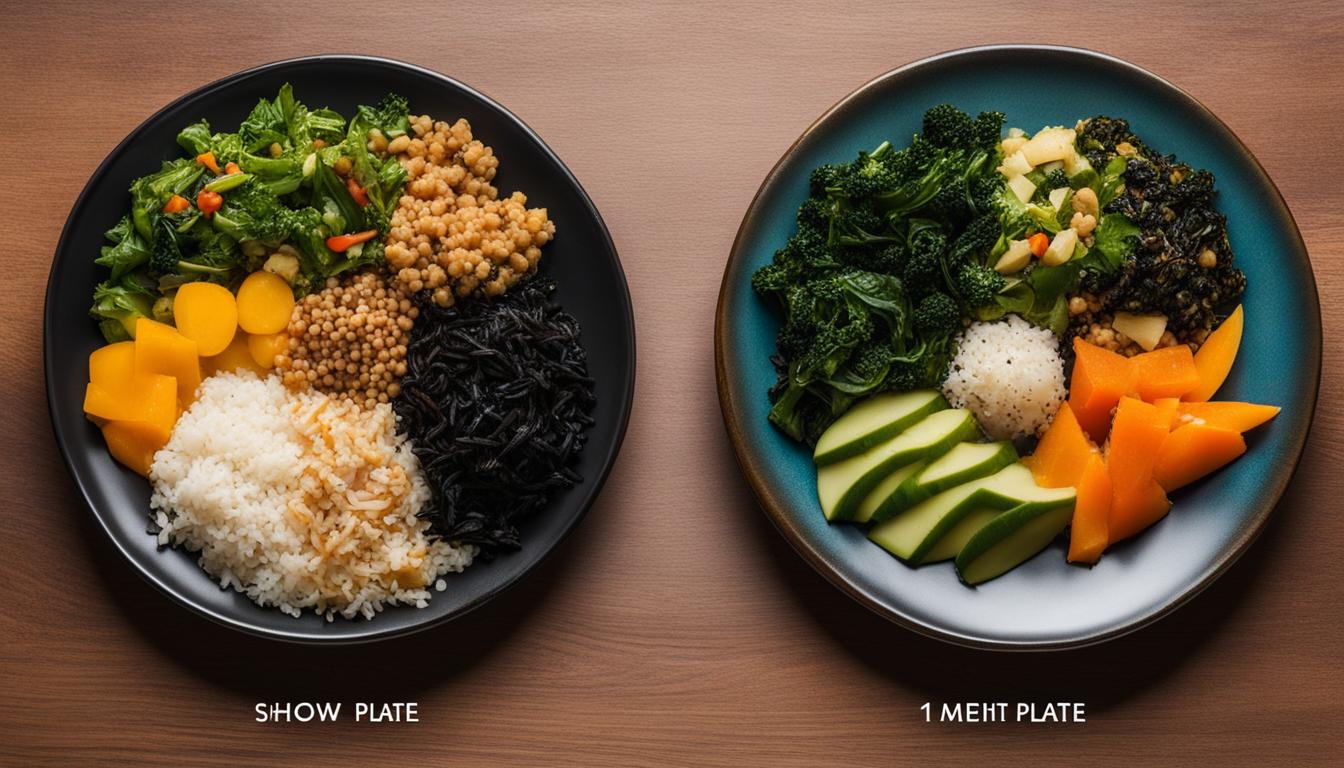If you’re trying to embrace a more sustainable and ethical eating plan, you may be considering a pescatarian or flexitarian diet. While both lifestyles share some similarities, they also have key differences that set them apart.
A pescatarian diet focuses on seafood and fish, while avoiding other types of meat. On the other hand, a flexitarian diet is more flexible and allows for occasional meat consumption while emphasizing plant-based foods.
Key Takeaways:
- A pescatarian diet includes seafood and fish while avoiding other types of meat
- A flexitarian diet is more flexible, allowing for occasional meat consumption while emphasizing plant-based foods
- Both diets share similarities in promoting sustainable and ethical eating choices
What is a Pescatarian?
Understanding the difference between a pescatarian and a flexitarian is the first step in exploring these two popular diets. While a flexitarian diet allows for a limited amount of meat consumption, a pescatarian diet includes fish and seafood, but excludes meat from land animals.
So, what does a pescatarian typically eat? A pescatarian’s diet primarily consists of fruits, vegetables, whole grains, legumes, nuts, and seeds, with fish and seafood providing a source of protein. This dietary choice is popular among those who want to improve their health or reduce their environmental impact.
Similar to flexitarians, pescatarians enjoy the flexibility of their eating habits. They have the option to include a limited amount of dairy and eggs, or to follow a completely plant-based diet while still getting the benefits of fish.
While pescatarians and flexitarians share similarities in terms of their plant-based focus and sustainable eating choices, the key distinction between the two diets is the inclusion of fish and seafood in the pescatarian diet. This allows for a wider range of food options and nutritional benefits.
What is a Flexitarian?
A flexitarian is someone who follows a flexible approach to their diet, incorporating both plant-based foods and occasional meat consumption. The term itself is a combination of “flexible” and “vegetarian”.
While flexitarians prioritize plant-based foods, they do not strictly avoid meat. Instead, they choose to consume it in smaller quantities and as a complement to their primarily plant-based meals. This approach is often motivated by concerns for personal health, animal welfare, and the environment.
Flexitarian diets share some similarities with pescatarian diets, such as a focus on plant-based foods and sustainable eating choices. However, the main difference is that a pescatarian excludes all meat except for fish and seafood, while a flexitarian is more flexible in their approach to meat consumption.
Some flexitarians may choose to eat meat only on certain occasions, such as when dining out or on special occasions. Others may limit their meat consumption to specific types, such as grass-fed beef or free-range chicken, in an effort to support more sustainable and ethical farming practices.
Comparing Pescatarians and Flexitarians: Similarities and Distinctions
While both pescatarians and flexitarians focus on incorporating plant-based foods into their diets, there are some notable differences between the two styles.
Pescatarians, for example, consume fish and seafood but avoid other meats such as beef, pork, and chicken. This means that they still get a source of animal protein and omega-3 fatty acids, which are typically lacking in a vegetarian or vegan diet.
Flexitarians, on the other hand, are more flexible in their approach and may consume small amounts of meat on occasion. They typically prioritize incorporating a variety of whole plant-based foods into their diets, while also being mindful of their meat consumption.
Both pescatarians and flexitarians share a focus on sustainability and ethical eating choices. By reducing their reliance on animal products, they can help minimize the environmental impact of food production while also supporting more humane treatment of animals.
Comparison of Pescatarian and Flexitarian Diets
To summarize, pescatarians and flexitarians share a focus on plant-based foods, but differ in their consumption of animal products. The table below highlights some of the key similarities and distinctions between the two diets:
| Pescatarian | Flexitarian | |
|---|---|---|
| Includes fish and seafood | Yes | Not necessarily |
| Avoids other animal meats | Yes | Moderate consumption allowed |
| Focus on plant-based foods | Yes | Yes |
| May prioritize sustainability and ethical eating choices | Yes | Yes |
Ultimately, the choice between a pescatarian and flexitarian diet will depend on personal preferences and beliefs. It’s important to carefully consider and research both options before making a decision, and to consult a healthcare professional to ensure that the chosen diet is nutritionally balanced.
Health and Sustainability Benefits of Pescatarian and Flexitarian Lifestyles
Adopting a pescatarian or flexitarian lifestyle comes with numerous health and sustainability benefits, making both diet styles a popular choice for individuals seeking a healthier and more eco-conscious way of living.
Benefits of a Pescatarian Lifestyle
By including fish and seafood in their diet, pescatarians are able to obtain essential dietary nutrients such as omega-3 fatty acids that are commonly lacking in vegetarian or vegan diets. These healthy fats are known for their numerous health benefits, including reducing the risk of heart disease and inflammation. Moreover, seafood is a low-fat, low-calorie source of protein that can help to maintain healthy muscles and bones.
Aside from the health benefits, pescatarian diets also promote sustainability through the conservation of marine life. As pescatarians refrain from consuming other animal meats, they are indirectly reducing their carbon footprint and promoting sustainable fishing practices. The demand for plant-based foods is also lower compared to strict vegetarian or vegan diets, making it easier to create a balanced and sustainable meal plan.
Benefits of a Flexitarian Lifestyle
Flexitarians enjoy the benefits of a plant-based diet while being flexible with their food choices, occasionally including meat and animal products. This diet style allows individuals to obtain the benefits of a vegetarian or vegan diet, such as a higher intake of fiber, antioxidants, and other essential nutrients found in whole foods, without having to completely eliminate meat. This flexibility can make this diet style easier to sustain in the long run, helping individuals to achieve their health goals while maintaining a balanced lifestyle.
Flexitarian diets also contribute to a sustainable food system by reducing the demand for meat and animal products, which have a significant environmental impact, including intensive water and land usage, greenhouse gas emissions, and overuse of antibiotics. Reducing meat consumption can lead to a reduction in the environmental footprint of individuals, positively impacting the planet.
Choosing Between Pescatarian and Flexitarian Diets
Deciding between a pescatarian and flexitarian diet depends on individual preferences and dietary needs. If you are seeking a diet that includes animal protein while remaining mostly plant-based, a flexitarian diet may be the best option for you. However, if you are looking for a sustainable and nutrient-dense diet that includes seafood, a pescatarian diet may be the way to go. It is important to consult a healthcare professional before making any significant dietary changes to ensure adequate nutrient intake.
Whatever your choice may be, incorporating plant-based foods into your diet and reducing your meat intake can lead to numerous health and sustainability benefits.
Making a Choice: Pescatarian or Flexitarian?
If you’re considering adopting a pescatarian or flexitarian diet, there are several factors to consider before making a final decision.
First, it’s important to understand the eating habits of both dietary lifestyles. Pescatarians avoid all meat except for fish and seafood, while flexitarians have a more flexible approach and occasionally consume meat in addition to plant-based foods. Consider which approach aligns best with your personal values and preferences.
Next, think about meal planning. Both pescatarians and flexitarians prioritize plant-based foods, but the specifics of their meal plans may differ. Research recipes and meal ideas that fit within each diet style to determine which would be the best fit for your lifestyle.
It’s also important to consider the potential health and sustainability benefits of each diet style. Pescatarians may benefit from increased omega-3 fatty acid intake, while flexitarians may experience improved digestion and reduced risk of chronic diseases due to their focus on plant-based foods. Both diets have been shown to have a lower environmental footprint compared to traditional meat-heavy diets.
Finally, it’s important to approach any dietary changes with a realistic and gradual mindset. Try incorporating more plant-based meals into your diet before fully committing to a pescatarian or flexitarian lifestyle. Seek guidance from a registered dietitian if needed.
In the end, the best dietary lifestyle is one that aligns with your personal values, preferences, and health needs. Take the time to research and experiment with different approaches to find the one that works best for you.
Making a Choice: Pescatarian or Flexitarian?
Now that you have a better understanding of the differences between pescatarians and flexitarians, you may be wondering which diet style is right for you. The truth is, there is no one-size-fits-all answer to this question. Ultimately, the decision comes down to your personal preferences and lifestyle choices.
If you are someone who enjoys seafood and is looking to reduce your meat intake, a pescatarian diet may be a good fit for you. On the other hand, if you want the flexibility to occasionally indulge in meat-based dishes while still prioritizing plant-based foods, a flexitarian diet may be a better choice.
Factors to Consider
When making a decision between these two diet styles, it may be helpful to consider factors such as your food preferences, budget, and cooking abilities. Do you have access to fresh seafood in your area? Can you afford to purchase high-quality plant-based products? Are you comfortable experimenting with new recipes?
It may also be helpful to consult with a nutritionist or dietitian to ensure that you are meeting your nutritional needs with whichever diet style you choose.
Practical Advice for Transitioning
Transitioning to a new diet can be challenging, but there are several practical steps you can take to make the process smoother. Start by gradually incorporating more plant-based foods into your meals, and experiment with new recipes and ingredients. If you are transitioning to a pescatarian diet, start by incorporating small amounts of seafood into your meals and gradually increasing your intake over time.
It’s important to remember that there is no right or wrong way to approach a pescatarian or flexitarian lifestyle. What matters is finding a sustainable approach that works for you and your individual needs.
The Bottom Line
Whether you choose to follow a pescatarian or flexitarian diet, making a conscious effort to prioritize plant-based foods and reduce your meat consumption can have numerous health and sustainability benefits. By taking the time to understand your options and make informed choices, you can develop a diet that is both delicious and eco-friendly.
FAQ
Q: How does a pescatarian differ from a flexitarian?
A: A pescatarian is someone who follows a diet that includes fish and seafood but avoids other animal meats. On the other hand, a flexitarian is someone who has a flexible approach to eating and includes both plant-based foods and occasional meat consumption in their diet.
Q: What is a pescatarian?
A: A pescatarian is someone who follows a diet that includes fish and seafood while avoiding other animal meats. It is a vegetarian-based diet that incorporates fish as the primary source of animal protein.
Q: What is a flexitarian?
A: A flexitarian is someone who has a flexible approach to eating. They focus on plant-based foods but also occasionally consume meat. The primary emphasis is on plant-based meals, with meat consumption happening in moderation.
Q: What are the similarities and distinctions between pescatarians and flexitarians?
A: Both pescatarians and flexitarians share a focus on plant-based foods and sustainable eating choices. However, pescatarians specifically include fish and seafood in their diet, while flexitarians have a more flexible approach that allows for occasional meat consumption.
Q: What are the health and sustainability benefits of pescatarians and flexitarians?
A: Both pescatarians and flexitarians can enjoy benefits such as increased nutrient intake, reduced environmental impact, and overall well-being. By choosing these lifestyles, individuals can contribute to a healthier planet and potentially improve their own health.
Q: How can I choose between a pescatarian and flexitarian diet?
A: When deciding between a pescatarian and flexitarian diet, it’s important to consider personal preferences, dietary restrictions, and sustainability goals. It can be helpful to experiment with both approaches and determine which aligns best with your lifestyle and values.
 Skip to main content
Skip to main content


